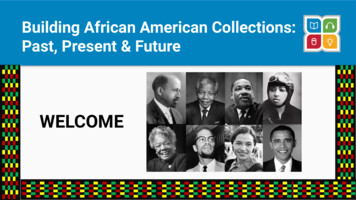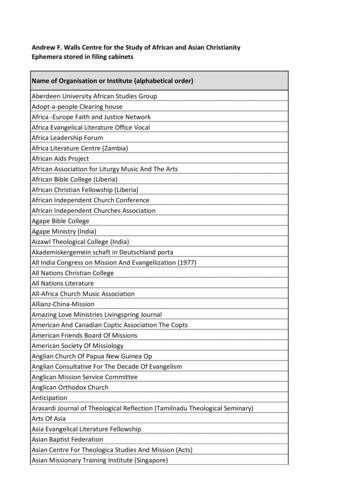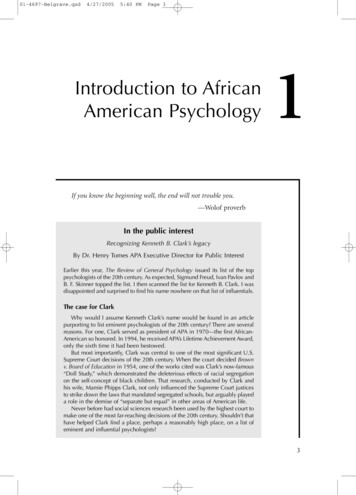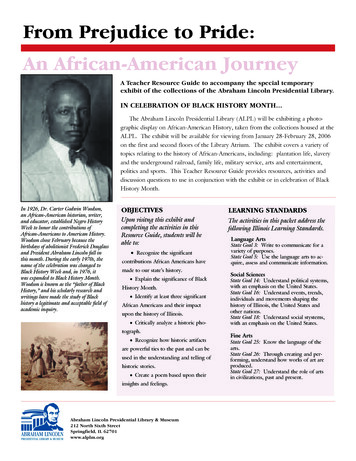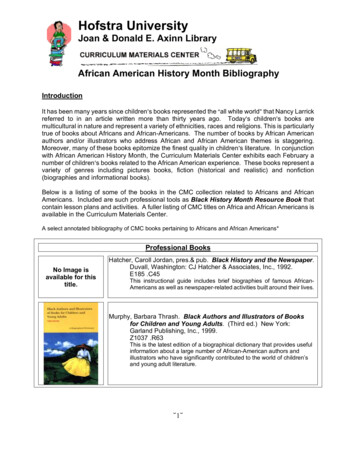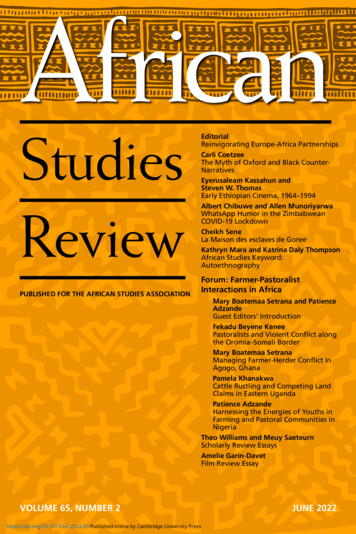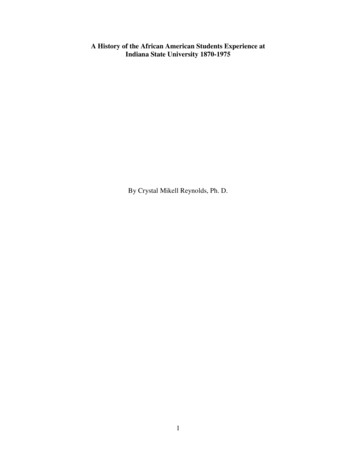
Transcription
A History of the African American Students Experience atIndiana State University 1870-1975By Crystal Mikell Reynolds, Ph. D.1
A History of the African American Students Experience atIndiana State University 1870-1975IntroductionThe story of African American students at Indiana State University throughout the decades toacquire an education is one of perseverance. It is a story of the Black students’ tenacity and faithin themselves, each other, and the University. Indiana State University should share in thisremarkable story for its courage and dedication in ensuring that all students received aneducation regardless of race.The Early Years(1870-1919)Established by the Indiana Legislature on December 20, 1865, the Normal School in Terre Hauteopened its doors to receive its first enrollment of 21 students on January 6, 1870. Its purpose wasto prepare teachers for the common schools of Indiana. The first president of Indiana StateNormal School (ISNS) was William Albert Jones (1869-1879).ISU’s relationship with students of African descent dates back to its initial year of 1870. AfricanAmericans had been a part of Terre Haute since 1816 when the first Blacks arrived in the city asindentured servants. Since the Indiana school system was largely segregated at the time, in 1869the Indiana General Assembly passed a law requiring separate schools for Blacks in districtswhere significant numbers justified them. It was appropriate, therefore, for Indiana State NormalSchool to prepare African Americans to teach in the classrooms of African American schools.Zachariah M. Anderson of Lost Creek was apparently the first Black student to attend the newNormal School, enrolling in the first summer session classes of 1870. Anderson was chosen to bethe first teacher in the newly established “colored school” located in the African MethodistEpiscopal Church on First Street in Terre Haute. This School would be the first state supportedschool for Blacks in Indiana.In September 1877, George W. Buckner from Indianapolis enrolled at the Normal School. Hedid not earn a degree, but was enrolled for several semesters. The presence of African Americansat the Normal School was a noteworthy achievement, since the other premier Indiana school nowcalled Indiana University, did not admit its first Black student until 1884. In June of 1885,another Black student, Albert E. Meyzeek of Terre Haute, registered at the School as well.Meyzeek went on to become the first principal of the 14th District School for Black children inTerre Haute, which he had been a leading force in helping to create. This first Black principalnamed to a Terre Haute school went on to serve Kentucky in the field of education for 40 years.Because the student records were lost in a devastating 1888 fire that destroyed the main buildingat the Normal School, it cannot be documented how many Black students attended the schoolbetween Anderson’s and Meyzeek’s admissions.The ISNS Normal Advance, a combination yearbook and newspaper published weekly andbegun in 1895, gives the first glimpse into the lives of African American students during the2
early years of the school (1870-1919). As early as 1895, a photo in the yearbook capturesAfrican American students studying in the school library, seated among their White counterparts.Formal photographs of African American students began as early as 1902 with the photograph ofVincennes resident and principal of the Colored High School of Vincennes, Wade Langford.However, while Black students’ attendance at the School may have been continuous beginning in1870, with the loss of the school records this information may never be verified.Another student, Evangeline Harris Merriweather, was pictured in the 1910 yearbook andgraduated from ISNS in 1911. Merriweather became a teacher, author, and soprano soloist whoperformed across the country. She also taught at Terre Haute’s Booker T. Washington andAbraham Lincoln schools. Her book, Stories for Little Tots (1940), was for elementary studentsand taught African American culture. She was referred to by African American scientist GeorgeWashington Carver as an early pioneer of the Civil Rights Movement.Still another student John W. Lyda (1886-1969), who graduated from ISNS in 1918, became acelebrated teacher at Booker T. Washington Junior High School (the Tenth District School) inTerre Haute during the early to mid-1900s and a respected ISNS alumnus. His book, The Negroin the History of Indiana (1953), received high acclaim and was a definitive study of the Blacksin Indiana up to that time. In the late 1960’s, his son Dr. Wesley Lyda became a moving forcebehind the development of the African American Studies Program at Indiana State Universityand became its first director.Although ISNS had a policy of open admittance from its inception, and although many Blackstudents graduated and went on to have successful teaching careers in Black schools, all was notfavorable for Black students at the School.A practice of the time, and perhaps most interesting and most revealing about the ISNSyearbooks in the early decades of the Twentieth Century, was the placement of photographs ofBlack students. Black students often were placed in a group after the pictures of White students.The practice of the editors of the yearbook of separating Black students in the yearbook, whichbegan in 1910, continued for several years of the Twentieth Century.It would seem that the segregated customs that were prevalent throughout the nation werepracticed, if not at the School itself, then, in the actions of the editors of the yearbook. Did thepractice of the placement of yearbook pictures mirror practices of the School during its earlyyears? It is clear that the Black students attended the same classes as the White students, andyearbook and related photographs show that Black students used the same academic facilities astheir White counterparts. Black students also sat in any seat they chose in the classroom. For themost part, African American students were also treated fairly by their White professors in theclassroom itself.Black students even participated on the same sports teams as their fellow students. LeonidasCasey Blake (1894-1991), a Terre Haute resident attended city schools before graduating fromISNS in 1917. Blake is believed to be one of the first African American athletes in any sport atISNS. He was reported to have been an outstanding athlete and was often featured in theSchool’s newspaper and even the yearbook.3
The fact that ISNS featured Blake in its 1915 yearbook and celebrated his achievements wasnoteworthy given the climate in the state of Indiana and the United States at that time. 1915 wasnot a particularly good year for African Americans in this country, for it was in that year that thebeloved African American leader Booker T. Washington passed away. And, perhaps equally asdetrimental to the Black culture, 1915 saw the rebirth of the Ku Klux Klan and the debut of themovie Birth of a Nation, a movie celebrating the Ku Klux Klan and demonizing anddehumanizing the African American male. Blake, therefore, must have been a tremendousathlete. Track and field appeared to be a sport opened to all, regardless of race. It would seemthat the School took pride in the achievements of its athletes regardless of their race.In the area of student organizations and clubs, there is also evidence that such organizations wereopen to Black students in these early years. Black students were members of the Equal SuffrageLeague of the State Normal School. Terre Haute resident Bertha Coakley was one such memberin 1913. However, social fraternities and sororities were not open to Black students at this time.These organizations would not be open to African Americans in practice for several decades.The 1920sThe 1920s was the decade of the flappers and new-found freedoms for many Americans; forAfrican Americans at ISNS it was the decade of the Black athlete. The School’s president duringmost of these years was Linnaeus Neal Hines (1921-1933). The 1922 Normal Advance was amirror to the racial culture at the School during the 1920s. The 1922 yearbook had as its frontcover to the activities section, a cartoon like picture of a dark skinned thick lipped Black mansinging joyously while being accompanied on piano by a dark skinned woolly haired Blackwoman also with thick lips. It would seem that in 1922, the editors of the yearbook believed thatBlack people loved to sing and were very satisfied with their lot in life. This stereotypicalcaricature of Blacks was commonplace in American life at this time.However, in the classrooms of ISNS itself, it appeared that Black students were not subject tosecond-class citizenship. There they were not relegated to sitting in the back of the classroom.And, despite the stereotypical imagery that surrounded them at the School, students continued toachieve in the classroom and to graduate. Science major David Duncan was selected as a cadetteacher, an honor only given to the most outstanding students. Exact data on how many Blackstudents attended the School or graduated during this era are not identified in School records.However, what was known was that in any given semester during the 1920s, there wereanywhere between 20 and 40 Black students in attendance out of total enrollments of 573 in1920; 1,393 students in 1925; and 1,392 students in 1929.What is perhaps remarkable for the era was the fact that in 1926, Warren Anderson, an AfricanAmerican athlete, received ISNS’s highest athletic award, a medal given annually by PresidentL.N. Hines to a student who earned a sports letter during the year and who during his previousthree terms had the highest average in scholarship among varsity men. Anderson, a graduate ofWiley High School in Terre Haute and a junior at the time of the award, excelled in the hurdlesand the broad jump. He went on to become a principal of Gary Roosevelt High School in Gary,Indiana and was the first Black member of the Indiana Board of Education. It is not known if any4
other African Americans received the Hines Award before Anderson. Today, the award is givento the graduating senior, athlete or non-athlete, with the highest grade point average.What is significant here is that at a time when African Americans were being systematicallydeprived of basic rights, especially educational rights, Indiana Normal not only opened its doorsto this group, but also seemed not to discriminate in the awarding of collegiate athletic awardsand in participation on most sports teams. More proof of this was given in the 1928 Sycamoreyearbook which highlighted the individual members of the 1927 football team. What stands outhere is that a Black student, Tindolph Cook of Bloomington, Indiana made the team and waspictured along with the non-Black members.Football was not the only sport opened to Black men in the 1920s; track continued to featurethem as well. The 1923 track team was composed of 23 men, one of whom was Black; the 1924track team was composed of 31 runners, three of whom were Black; the 1925 track team wascomposed of 31 runners, four of whom were Black.The 1925 track team included William “Babe” Holland. Holland, one of four members of thefamed “wonder team,” was a sprinter and a hurdler. In 1925, Holland set a school record for the100 yard dash (10.1). Holland went on to have successful teaching and administrative careers inTexas.By 1927, the track team was composed of 35 runners, six of whom were Black. One of theseBlack student athletes was Sylvestor “Sy” Laffoon. This Wiley High School and ISNS track starwas the son of a local business owner and father of famed Terre Haute educator BarbaraSizemore. In 1928, a Black female track member was listed on the 13-member women’s trackteam. Unfortunately, her name is not known. Despite these strong showings by Black athletes onthe football and track teams, there were no Black members on the School’s baseball andbasketball teams during this decade. However, despite the absence of Black players on the twoother major teams, it is quite clear that in terms of athletics, ISNS was well ahead of many of itscollegiate counterparts in the acceptance and recognition of Black athletes.In the area of campus organizations, Black students were members of a few organizations, theEclectic (a literary organization), the Spanish Club, the YMCA, the Band, the Orchestra and theStudent Council. The Student Council was not always open to Black students, however. Not until1929 was the segregated Student Council disbanded. In 1929, a new student constitutionformally gave Black students a seat on the Student Council. Such a seat had been denied to themin March of 1927.Segregation was present in other aspects of campus life as well, including eateries, housing, andmeeting spaces. Black students did not have access to campus lockers until 1929 when thenumber of Black students increased, as previously they were not allowed to have lockers in thesame buildings as their White counterparts.Another change occurred in January 1929, when Black students were given access to therecitation room of the deceased Professor Gifford. The recitation room, located in the basement5
of one of the classroom buildings, was to be used as a storage facility, eatery, and gathering placefor Black students.Although segregated social facilities were maintained at this time, it would seem that byproviding facilities for Black students in 1929 the School attempted to ensure that life for Blackstudents, although separate was to some degree equal. However, the School did not control themembership of chartered national social fraternities and sororities which remained closed toBlack students. The practices of ISNS in the 1920s seemed to uphold the segregated practices ofseparate but equal of the time, which had become the law of the land in 1896 as a result of thePlessey vs. Fergusen Supreme Court decision.Since Black students were not accepted in White sororities and fraternities, they established theirown social organizations. One of the earliest was the Black organization AMICITIA, the Latinword for friendship, in existence from 1920-1924.The 1930sThe 1930s was the decade of depression and hardship for most Americans, but was also a periodof change for Indiana State students. Reflecting both higher educational requirements forcertification of teachers in the Indiana public schools and an increasing number of Indiana Stategraduates who went into professions other than teaching, the Normal School became IndianaState Teachers College (ISTC) in 1929. Its presidents during this period were Linnaeus NealHines (1921-1933) and Dr. Ralph Noble Tirey (1934-1953).The Great Depression greatly affected African American residents in Terre Haute and ISTCstudents during the first half of the decade. The number of African American Students at theCollege during the 1930s was now between 30 and 40 students. The total student enrollment was1,503 in 1930; 1,723 in 1932; 1,269 in 1935; and 1,599 in 1939. While the majority of AfricanAmerican students who continued to enroll at ISTC were from Terre Haute, other Indiana townsand cities continued to be represented: Brazil, Indianapolis, Gary, East Chicago, Anderson,Evansville, Greencastle, and even Rushville were represented as well as Louisville andEarlington, Kentucky. At this time tuition remained free to Indiana residents.For African Americans at Indiana State Teachers College during the 1930s getting a teachingcertification or education degree was their main goal, for these documents allowed the Blackstudents to work in the “Colored Schools” across Indiana, which was their ultimate goal. Beingaccepted socially by their White counterparts or being fully integrated into the fabric of theCollege were unrealistic goals for most African American students at this time. Such goals forAfrican American students would come much later at Indiana State University.In the 1930s, Black males and Black females continued to excel in the classroom. In theclassroom itself as in previous decades, both anecdotal and written evidence support the beliefthat Black students were not subject to seat segregation or any other segregated classroompractices.6
Not only were Black students excelling in the classroom in the 1930s, but Black males as well asBlack females were receiving recognition in and excelling at athletics as had been the trend inthe previous decade. In 1931, Donald Porter, a Terre Haute native, received the Bigwood Awardfor his outstanding track performance. The Bigwood Award was presented each year to theathlete based on outstanding athletics, scholarship, loyalty, and other factors. He was featured inthe Indiana Statesman and in the 1931 Sycamore yearbook. Porter’s receiving the coveted 1931Bigwood Award and receiving the print media attention that ensued are remarkable feats forAfrican Americans for the period.Jesse Oliver May, another 1930s Black athlete, was featured in the 1933 yearbook. May was alsoa member of the track and intramural baseball and basketball teams. He earned a football varsityletter and sweater in 1931. After graduating from ISTC in 1933, May pursued a doctoral degree,eventually returning to Terre Haute to teach at Booker T. Washington Elementary School in1947.In 1933, Junius “Rainey” Bibbs was a standout in baseball. Bibbs was one of the most celebratedBlack athletes both during his years at ISTC and in subsequent years. Bibbs not only playedbaseball but played fullback on the football team as well. After graduating from ISTC, he wenton to play eight seasons with the Negro Baseball Leagues (1936-1944) and helped his team towin three league championships. Because of his remarkable baseball feats, he was inducted intothe ISU Hall of Fame in 1998.1939 seemed to be the year of Coleridge Churchill. He was a standout on both the track andfootball teams. After graduating from ISTC, Churchill became a celebrated member of thefaculty at Lincoln High School in Evansville, Indiana. He would serve in several administrativeroles in Evansville until his retirement.However, in the 1930’s participation on the official basketball team was still closed to Blackstudents. But, Black students were allowed to compete on separate “colored teams” under theumbrella of Indiana State Teachers College.Black men were not the only members of the African American student population who wereboth achieving and being recognized for their success in athletics at the Teachers College duringthis time. In 1930 the Black students could even boast of having one of their own in theprestigious “I” women, the highest award that a woman in a campus organization could earn. In1930, Georgia Offutt from Indianapolis received this honor along with eight of her Whitecounterparts. She was prominently featured in the yearbook. After graduating from ISTC, Offuttjoined the faculty at Crispus Attucks High School in Indianapolis.The 1933 yearbook also pictured an unidentified Black woman star runner. In 1936, there wereBlack women on both the soccer and hockey teams. Nancie Ellison was one such athlete. It isunfortunate that more is not known of these Black women athletes. It is also unfortunate that notall of the Black female athletes’ names were given in the yearbooks and Statesman newspaper ata time when their Black male and White female counterparts were being named and lauded.7
It would seem that in the arena of sports, Black students, especially Black males, achieved somedegree of equality at ISTC. By the 1930s, athletics was not the only arena open to Blackstudents, for Black students were also active in campus student organizations or “clubs,” as theywere referred to on campus. They were members of general student organizational clubs such asthe Student Council, W.A.A. Council, the Poet’s Club, the YWCA, and the Athenaeum, anorganization composed of physical education majors. Mabel Evans (1918-2004) was one suchmember of Athenaeum. The daughter of Terre Haute civil rights activist and Terre Hautemayoral candidate Grace Wilson Evans, Evans was a physical education major and received herBachelor of Arts degree in 1938. She taught briefly at various Terre Haute schools beforepursuing a Master's degree at the University of Wisconsin. She worked in the field of nutritionfor most of her career and was honored by ISU as a distinguished alumna in 1984.Other organizations Black students participated in were entertainment related clubs such asSycamore Review, the chorus, and the band. Academic clubs also opened their doors to Blackstudents. These included the prestigious Kappa Delta Pi, international honors fraternity, includedin its membership Naomi Mitcham, an upperclassman from Indianapolis, the only AfricanAmerican student in the club that year and for many years after; the Social Studies Club; and theElementary Department Club, which appeared to be a very popular club among Black studentsduring this decade.While many school organizations did open their doors to Black students, there was one arena thatremained closed to this group: traditionally White national social fraternities and sororities. Itseemed clear that such social organizations were off-limits to Black students at ISTC, a practicecommon at predominantly White universities all across the United States at this time.While Black students were achieving some success both in the classrooms, on sports team, andin general campus organizations, they were still not able to share a dorm room with their fellowWhite counterparts. In fact, both Black women and men were not able to reside on ISTC’scampus for two more decades. Reeve Hall was the second residential facility for women at ISTC.It was founded in 1925 for female students, White female students, although the TeachersCollege had never stated officially that it was for Whites only. However, by 1930, Indiana StateTeachers’ College did not conceal the fact that Black students were not allowed to reside oncampus with their White counterparts; this fact was now an official written policy.In 1934, Indiana State purchased a house off campus to board Black women students who werenot permitted to reside in Reeve Hall. Named after the great 19th century African Americanwoman poet, Phyllis Wheatley Hall was located in the 1100 block of Poplar Street, in TerreHaute, more than a mile from the campus.Arguably, although Wheatley Hall maintained the segregated customs of the times, it can beinterpreted as an attempt by ISTC to ensure that African American women would not be deniedaccess to adequate housing while attending the school.The House was in full operation from 1934 to 1945 and no other house for either AfricanAmerican women or men was ever established. (By 1945 the house was no longer in operation;however, no equivalent house was established for Black women and Reeve Hall remained8
“Whites only”). Black females found lodging in the homes of local Black families or with Whitelandlords who rented to Black students, and such landlords in Terre Haute were rare. It should benoted that the Teachers College established no equivalent hall for the Black men at this or at anyother time at the University. Throughout the history of ISTC, a dormitory for male students wasnot established until 1937 when Parsons Hall was constructed to house White male students.Like the female residence halls, Parsons Hall was designed and built to house White students.Not only were Black students not allowed to reside on campus during the 1930s, they were alsonot allowed to eat at any of the Teachers Colleges’ dining facilities at this time as well. Although“separate but equal” was being practiced at ISTC in the area of residential facilities for Blackwomen, this doctrine fell short when it came to dining facilities, for there were no diningfacilities for Blacks on campus. Blacks had to be creative when it came to eating facilities.A local African American eatery operated by Mr. and Mrs. Weathers and located by AllenChapel (local Black church) and Phyllis Wheatley Hall made it possible for Black students to geta square meal at a reasonable price.Living and eating facilities were not the only aspects of campus life that were off- limits to Blackstudents during the 1930s; mainstream dances and proms were also off-limits to this group aswell.Not being accepted in the White sororities and fraternities and not being accepted in the sociallife on campus, Black students established their own social organizations.The Ivy Leaf Club, a women’s sorority, was founded by Black female students in 1932 at ISTC.It was a local branch of the national sorority Alpha Kappa Alpha, founded in 1908 at HowardUniversity, but not officially colonized at Indiana State until 1969. The Ivy Club was a verypopular club among the African American female students and the national AKA organizationcan credit local member and musician Evangeline Merriweather for its official pledge songwhich eventually became the official song for the Alpha Kappa Alpha sorority.One of the most popular and successful organizations at this time was the Statonian Club. Agroup of Blacks organized the Statonian Club in the fall of 1937. The first president was EastChicago student Quentin Smith. The organization, which until 1940 admitted only Black males(after that date it also admitted Black women), had the purpose of improving the social,economic, and cultural conditions experienced on the campus. The interests of Black studentsand the need for cooperative effort (to bring about change) resulted in the club’s expansion in thelate 1940s. In 1948, Catherine Wilson of Indianapolis was chosen as Statonian Queen and futureTerre Haute historian Geneva Ross was an active member of the organization.Not only did the Black students establish organizations to help deal with life on a predominatelyWhite campus, the Teachers College also established an organization as well. The collegeestablished the Inter-Racial Club in 1939 to help bridge the racial gap and to help students get toknow each other better. However, the group was short-lived.9
The 1940sThe 1940s was the decade of war and rebuilding for America, for African Americans at ISTC itwas the decade of increased opportunity. President Ralph Tirey was president during all of the1940s; his term actually ran from 1934-1953. Still, in the 1940s, the “separate but equal” policywas in effect in many areas of the campus as well as across the nation. However, there would bea few positive changes in the area of race relations at the Teachers College.In the area of academics, Black students continued to graduate in decent numbers and achievedsuccess in their careers. There was an increase in African American students in the pre-and postwar years. The enrollment numbers of Black students at this time varied from 40 to 50immediately before and during World War II and to 60 and 70 after the war. The totalenrollments of all students during this decade were as follows: 1940, 1,636; 1943, 750; 1945,788; 1946, 2,266 and 1947, 2,555.In athletics, African Americans continued to participate with some measure of success. In theworld of football, in 1940, Marvin Mosely and Harry Taylor were standouts on the football team.In 1941, Quentin Smith was an outstanding tight-end on the football team. In 1942, two Blackfootball players, Mosely and Oscar Reeder were among those who made up a nationallyacclaimed defensive line. In 1948, Bernie Render, an African American student from TerreHaute, was a star defensive back on the football team.In track and field, in 1942-1943 saw an increased number of Black track members. Wally Darius,John Mitchem, David Smith, Oscar Reeder, Robert Hoke, and Harry Taylor were all part of the15-member track team.However, it was not until 1947 that ISTC’s basketball desegregated. In 1947 an event whichdemonstrated the Teachers College’s awareness of its responsibility to its Black studentsoccurred. After achieving an 18-7 basketball season, John Wooden, in his first season as a coachat the Teachers College, prompted the School to refuse a National Association for IntercollegiateBasketball tourney bid because the host organization, the National Association of IntercollegiateBasketball, would not allow Clarence Walker, the team's only Black player, to play in thetournament. At the time, the National Association for Intercollegiate Basketball (NAIB) tourneywas enforcing an all-White rule. The overall response to the Teachers College’s stance from theTerre Haute community was favorable. In part, because of the Teachers College’s stand, thefollowing year NAIB dropped its insistence that Walker, also a member of the 1947-1948 team,not compete. These events demonstrated that the Teachers College was beginning to becomesensitive to the negative forces of the segregated practices of the time.Black students were also having success in student life and in campus organizations in general.A club that Blacks were first time participants in was the prestigious publication Who’s Who inAmerican Colleges and Universities, including Clinton A. Mitchem of Indianapolis. Mitchemwas featured in the 1947 yearbook, with a whole page devoted to him. He was one of 11 studentsgiven the Who’s Who honor. Mitchem also served as vice president of the Student Union Boardand, even more significantly, was elected two years later as vice president of the senior class, arare feat for Black Americans at predominately White colleges at this time. Mitchem was not the10
only Black member of the Student Union Board during the latter part of the 1940s, as anincreased participation of Blacks on the Student Union Board was clearly shown.Not only did Mitchem serve on the Student Union Board, but in the early 1940s so did stand outathlete Quentin Smith of East Chicago who also served on the Student Council along with TerreHaute natives Josephine Evans and Dharathula “Dolly” Ho
Established by the Indiana Legislature on December 20, 1865, the Normal School in Terre Haute opened its doors to receive its first enrollment of 21 students on January 6, 1870. Its purpose was to prepare teachers for the common schools of Indiana. The first president of Indiana State Normal School (ISNS) was William Albert Jones (1869-1879).


